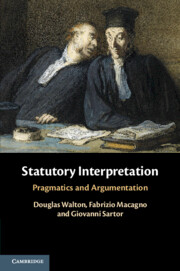Book contents
- Statutory Interpretation
- Statutory Interpretation
- Copyright page
- Dedication
- Contents
- Figures
- Tables
- Acknowledgments
- Introduction
- 1 Interpretation and Statutory Interpretation
- 2 Statutory Interpretation as Problem Solving
- 3 Interpretation and Pragmatics – Legal Ambiguity
- 4 Pragmatic Maxims and Presumptions in Legal Interpretation
- 5 Arguments of Statutory Interpretation and Argumentation Schemes
- 6 Classification and Formalization of Interpretative Schemes
- References
4 - Pragmatic Maxims and Presumptions in Legal Interpretation
Published online by Cambridge University Press: 29 December 2020
- Statutory Interpretation
- Statutory Interpretation
- Copyright page
- Dedication
- Contents
- Figures
- Tables
- Acknowledgments
- Introduction
- 1 Interpretation and Statutory Interpretation
- 2 Statutory Interpretation as Problem Solving
- 3 Interpretation and Pragmatics – Legal Ambiguity
- 4 Pragmatic Maxims and Presumptions in Legal Interpretation
- 5 Arguments of Statutory Interpretation and Argumentation Schemes
- 6 Classification and Formalization of Interpretative Schemes
- References
Summary
In our previous chapter on ambiguity, we underscored how the logical form of a legal statement does not provide the proposition expressed. The meaning of an utterance – the product of a verbal act performed in a specific context (Leech 1983, 14) – cannot be the simple output of a decoding process (Sperber and Wilson 1995, 182; Recanati 2003, 56), or “semantic interpretation” (Leech 1983, 5). The logical form (also called “semantic representation”) that can be recovered through the mere decoding of an utterance through the application of the rules of grammar (Sperber and Wilson 1995, 9–10) does not deliver complete propositions, but only “semantic schemata” (Recanati 2003, 56).
- Type
- Chapter
- Information
- Statutory InterpretationPragmatics and Argumentation, pp. 157 - 204Publisher: Cambridge University PressPrint publication year: 2021
References
References
Cases Cited
Bond v. United States 2011 564 U.S. 211.
Dunnachie v. Kingston-upon-Hull City Council 2004 UKHL 36.
Garner v. Burr [1951] 1 KB 31.
Nix v. Hedden 1893 149 U.S. 304.
Smith v. United States 1993 508 U.S. 223.
United States v. Bronston 1971 453 F.2d 555.



